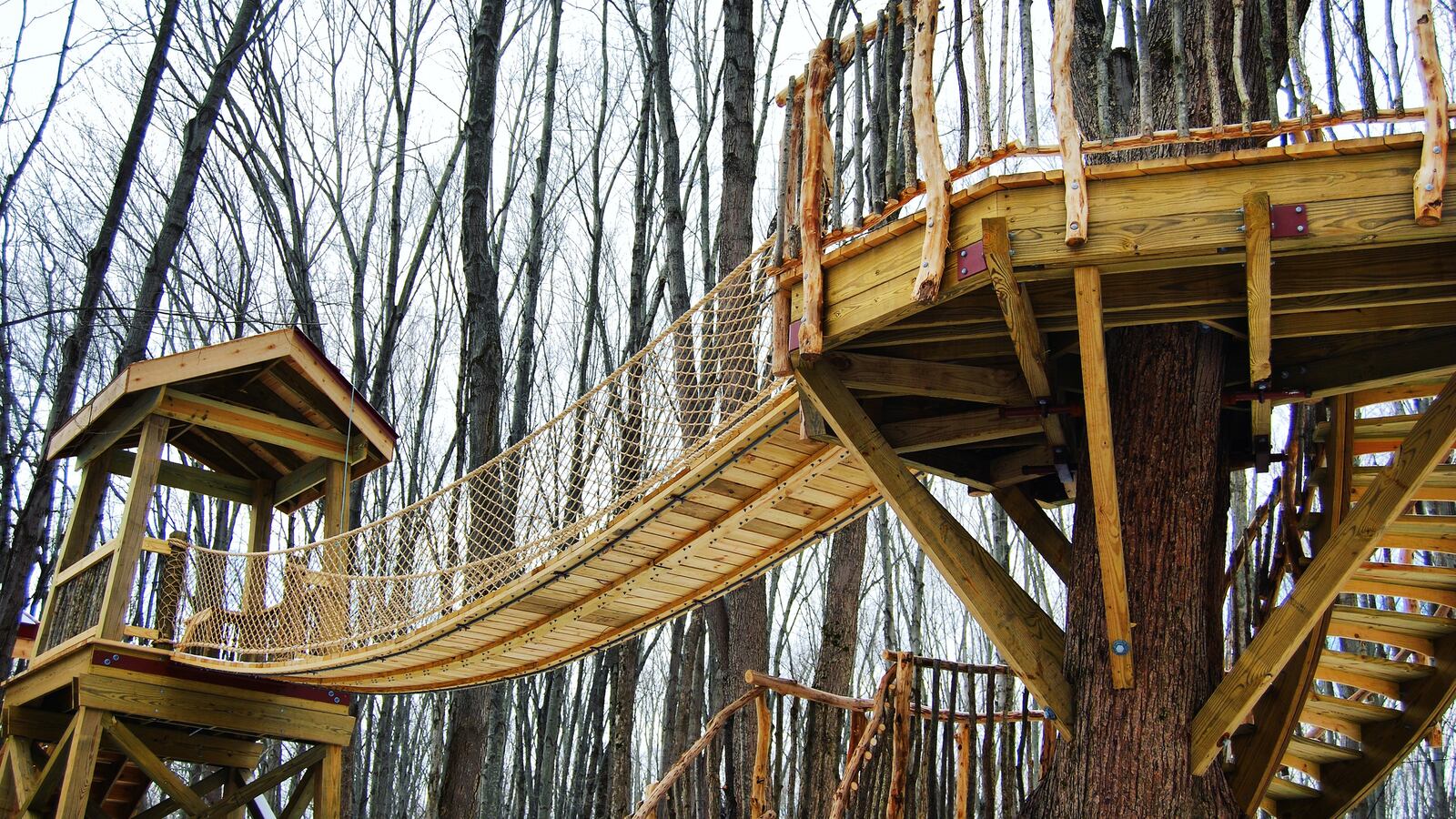When my spouse was a kid, she started a nature club in a treehouse her father built in the family apple orchard. The oldest of five, she named herself president and enlisted other kids in the neighborhood as members—whom she also had pay dues and convinced to put on plays. A child needs very little to conjure up stories, but put that child in an orchard with a treehouse, and you give her an entire universe to fill.
From the elaborate treehouse of the Swiss Family Robinson to the classic hideaways of Stand By Me or The Simpsons, treehouses are one of the greatest symbols of childhood. In recent years, they have been experiencing an adult-ified revival, taking on elaborate architecture and size—both as private, backyard retreats and as alternative vacation lodging options, a trend known as glamping.
I was recently pulled back into this magic when an incredible treehouse project built for the public was announced by Metroparks Toledo (of which I’m a member) in Northwest Ohio. Called the Cannaley Treehouse Village, the build is underway at Oak Openings Preserve Metropark in Swanton, Ohio—a small community in the greater Toledo area—and is slated to open to the public in early 2020.
Want more Daily Beast travel stories? Sign up for our weekly newsletter here!
Anecdotally, it seems like I’m always spotting a new treehouse somewhere in Ohio—a state where parks offer lessons on tree climbing and Cleveland has the must-see Murch Canopy Walk and tower. (Canopy walks are wooden bridges or rope walkways that allow humans to access the tree canopy and can be anywhere from 20 to nearly 100 feet in the air.)
But not everyone has the ability, money, or even trees to build their own treehouse, so a public treehouse village, like that at Metroparks Toledo, helps to fill that gap and provide an experience most cannot have at home.
(To be honest, it also reflects my desire to have a treehouse.)
“Metroparks Toledo’s mission is to protect and conserve the region’s natural resources and connect people to them,” says Emily Ziegler, chief of planning and capital projects for Metroparks Toledo. “Treehouses offer a comfortable way to experience nature while also igniting a sense of adventure and childhood excitement.”
Maybe it was that childhood excitement I felt when I jumped at the opportunity to see the village. It was a cold, gray day, but I sludged through tire-rutted mud to the build site the village calls home for a tour with Scott Carpenter, Metroparks’ director of public relations.

The Treehouse Village is set up at Oak Openings’s Beach Ridge trailhead, a new single-track mountain bike trail with a series of skill challenges, and also just around the corner from the new Beach Ridge Wheelhouse, a stylish bike-and-forest-themed venue for parties, with a tree built into it. At the entrance is a sculpture made entirely from bike frames.
Just being there triggered the adventure gene for me.
The project’s 1.3 acres of village habitat is in various stages of completion. The heart of it is the nearly finished common treehouse, a gathering spot for those staying in the village or for group events. From the common treehouse is a short canopy walk to the crow’s nest—a viewing platform in the trees.

To the left, square platforms up in the trees allow guests to set up a tent or hammock. There will also be four (2-6 person) treehouses for overnight stays. Each treehouse will be fully furnished with heat, air, and electricity, though only the larger, family-sized treehouses with composting toilets. There is a common area for showers and restrooms.
To foster that childlike enthusiasm, each treehouse will also have its own unique features, like a slide, fire pole, climbing wall or netting for those who want to come and go with some outdoorsy-panache.
In other words, these treehouses can be a type of gateway accommodation for those who are not entirely comfortable with the outdoors or sleeping on the forest floor. Here you get a chance to absorb the sounds and scents that come with what is dubbed “forest bathing”—soaking in the atmosphere of a forest—but at night you’re tucked away in the walls of the treehouse.
The location also takes advantage of Northwest Ohio’s growing world of ecotourism, including extensive cycling and hiking trails, as well as the region’s rich birding opportunities. Ziegler believes the Village will help connect people to these experiences.
Treehouse Village is possible, in part, because of the current popularity of shows like Treehouse Masters on Animal Planet. Now 11 seasons in, the show features large and small treehouses, frequently decked out with comfortable rooms, imaginative designs, and beautiful views.
“Building a treehouse village was something we had dreamt about for years,” Ziegler tells me. “We were familiar with Treehouse Masters’ ‘whimsy’ designs and also their proprietary hardware used to safely attach and support the platforms, while allowing for growth and sway of the trees.”
They reached out to Nelson Treehouse, the family behind the show, and that dream took a large step forward to reality. Nelson’s team taught the Metroparks how to build their village.
“Partnering with Metroparks Toledo on the Treehouse Village has been such a meaningful project because it brings the joy of treehouses to more people,” says Pete Nelson, host of Treehouse Masters. “My team and I love working on public treehouses for that reason: getting more folks out into nature and up into the trees.”
And this brings me back to the many treehouses—private and rental—I’ve begun to see in Ohio and on road trips in the Midwest.
Nelson tells me that “interest in treehouses really seems to know no geographic bounds,” but at regional home and garden shows he does frequently meet Midwesterners working on treehouses. “There also seems to be a particularly strong tradition of DIY treehouse building in the Midwest,” he adds.
Clearly, treehouses are compelling places to be, unique and almost fairytale like in nature, with some of the mystery of an Ewok village. This is partly behind the growing trend of treehouses as vacation lodging options.
“Treehouses are definitely the favorite accommodation to book,” Ruben Martinez, co-founder of Glamping Hub tells me. Glamping Hub has 425 treehouses in countries globally. “In 2018, in the list of 50 most-booked accommodations on Glamping Hub, 10 were treehouses,” he adds.
Ohio has several of these luxury treehouse lodging options—particularly south of Cleveland—like Berlin Woods and The Mohicans. These are rustic-yet-boutique accommodations, offering the luxuries of what you want in lodging—living rooms and decks with dramatic views, lofts, full bedrooms, kitchenettes, and in some cases, seasonal outdoor showers—while also taking you away from it all, by placing you several feet into the air in a unique wooded setting.
(The Mohicans even has two treehouses designed by Pete Nelson and caught the attention of couples like actor Matthew McConaughey and model and designer, Camila Alves. This year, Alves’ Women of Today gave away free nights at The Mohicans.)
“People are driven by this unique experience and trying something different,” says Martinez.
To me, there is also a primal appeal to climbing up into the canopy—something I experience when I’m out hiking. There is a bonding to the living, breathing forest—of being a guest of the connected and aptly named Wood-Wide Web. There is something special about tracing the distinct lines of crown shyness (when the crowns of trees refuse to touch) with your eyes. It is a reminder that nature is our first home—treehouses are a blend of our current homes with that original space.

“Our love of tree-climbing and treehouses most certainly came from our ancestors,” Dr. Meg Lowman, the director of TREE Foundation, tells me when I ask her about her work on trees. Lowman is a canopy explorer and forest conservation biologist. “After all, we originated in the trees.” She jokes that she wishes she had a handy tail when she’s up there.
“I believe that children love tree-climbing as a primal instinct and that adults as well as kids resonate to treehouses because it is part of our evolutionary heritage,” adds Lowman. “There is something special about being in a tree house, and not just the wonderful oxygen up there, but also the view, the surrounded-sound nature and the sense of escape from our planetary stresses.”
In other words, treehouses allow us to slip the surly bonds of adult pressures and refresh.
“They harken back to the whimsy of childhood dreams,” Nelson tells me. “And they have a beautiful ability to connect our past with our future: when we build treehouses for our children, we link our own childhoods to theirs.”
Ultimately, it is that connection that is hard to disagree with; returning back to that childhood under the nature club presidency of my spouse, her youngest brother eventually built a treehouse for his own kids—passing on those experiences he loved and giving them a new perspective on what a tree can be.
When we climb a ladder or stairway upwards, whether it is at home or at the Treehouse Village, we are taken places without needing to travel far away. Treehouses refuel our imaginations and they give us license to re-discover the outdoors, reuniting us with the forest.
And they even have the power to turn us into time-travelers, where being a child can feel the most like being human.






